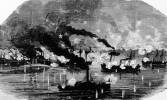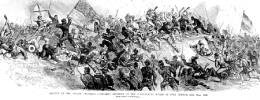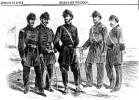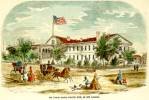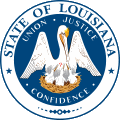 | Find Louisiana State Museum on Facebook |
 | Find Louisiana State Museum on Twitter |
| 2016 Sunset Report |
| OLG & DCRT Strategic Plan 2020-21 through 2024-25 |

- Quality - Louisiana State Library
85% of the users of the State Library indicated that the State Library's services and resources was a good value for the State.Source: The Impact of the Louisiana Department of Culture, Recreation and Tourism on Louisiana's Economy and Quality of Life for Louisiana's Citizens - June 2006
- Louisiana's deep water ports
Did you know that Louisiana's five deep water ports handle more than 457 million tons of U.S. waterborne commerce a year? - Quality - Louisiana State Library
85% of the users of the State Library indicated that the State Library's services and resources was a good value for the State.Source: The Impact of the Louisiana Department of Culture, Recreation and Tourism on Louisiana's Economy and Quality of Life for Louisiana's Citizens - June 2006
- Atchafalaya Heritage Area
The Atchafalaya Heritage Area has been designated by Congress as a National Heritage Area.
- Impact - DCRT Returns Investment Dollars to Louisiana
For every state tax dollar spent by the Department of Culture, Recreation and Tourism, $5.86 is returned to the State Treasury and citizens of Louisiana.Source: The Impact of the Louisiana Department of Culture, Recreation and Tourism on Louisiana's Economy and Quality of Life for Louisiana's Citizens - June 2006
- Impact - Louisiana Office of Tourism Tops Returns on Investment
$13.90 is the return on investment for every dollar spent by the Office of Tourism. Over 175,000 people were directly employed by the Louisiana travel and tourism industry in 2004. In terms of production, $5.9 billion (3.8%) of Louisiana's Gross State Product was directly attributable to expenditures by visitors to LouisianaSource: The Impact of the Louisiana Department of Culture, Recreation and Tourism on Louisiana's Economy and Quality of Life for Louisiana's Citizens - June 2006
- Impact - Supporting the Louisiana Arts
Every dollar in state support for the Arts leverages $7 in earned and contributed revenue. Louisiana's cultural enterprises provide nearly 144,000 jobs for Louisiana citizens, accounting for 7.6% of total employment. Arts has a total economic impact of $934 million in Louisiana.Source: The Impact of the Louisiana Department of Culture, Recreation and Tourism on Louisiana's Economy and Quality of Life for Louisiana's Citizens - June 2006
- Impact - Visitors Generate State Revenue
In terms of tax revenues, visitor spending accounted for $677 million of 2004 Louisiana revenues, or 8.3% of the total 2004 State Budget.Source: The Impact of the Louisiana Department of Culture, Recreation and Tourism on Louisiana's Economy and Quality of Life for Louisiana's Citizens - June 2006
- Quality - Louisiana State Museums
95% of State Museum's visitors strongly agreed or agreed that the State Museum was an educational experience and has expanded their awareness of Louisiana's cultural history.Source: The Impact of the Louisiana Department of Culture, Recreation and Tourism on Louisiana's Economy and Quality of Life for Louisiana's Citizens - June 2006
- Quality - Historic Preservation and the Arts
78-80% of Louisiana residents believe that historic preservation and arts are important and should be high priorities.Source: The Impact of the Louisiana Department of Culture, Recreation and Tourism on Louisiana's Economy and Quality of Life for Louisiana's Citizens - June 2006
- Impact - Louisiana Serve Program
The Louisiana Serve Program in the Office of Lieutenant Governor returns 2.8 million in non-state revenue to Louisiana. - Impact - Louisiana State Museum
The Office of State Museum returns $6.99 for every tax dollar spent.Source: The Impact of the Louisiana Department of Culture, Recreation and Tourism on Louisiana's Economy and Quality of Life for Louisiana's Citizens - June 2006
- Impact - Louisiana State Parks
Visitor spending at Louisiana State Parks returns $3.23 in state taxes for every dollar spend on operating and maintaining all our beautiful parks. Out-of-state visitors to Louisiana State Parks spent almost $12 million in Louisiana and produced an economic impact of over $24 million. Louisiana residents spent another $29.2 million while visiting the parks.Source: The Impact of the Louisiana Department of Culture, Recreation and Tourism on Louisiana's Economy and Quality of Life for Louisiana's Citizens - June 2006
- Impact - Scenic Byways Program
The Scenic Byways program leverages $1.56 for every dollar spent by the program.Source: The Impact of the Louisiana Department of Culture, Recreation and Tourism on Louisiana's Economy and Quality of Life for Louisiana's Citizens - June 2006
- Louisiana State Parks and the National Register
Thirteen Louisiana State Parks sites are on the National Register of Historic Places. They include:
• Audubon State Historic Site
• Centenary State Historic Site
• Fort Pike State Historic Site
• Fort Jesup State Historic Site
• Longfellow-Evangeline State Historic Site
• Mansfield State Historic Site
• Marksville State Historic Site
• Plaquemine Lock State Historic Site
• Port Hudson State Historic Site
• Poverty Point State Historic Site
• Otis House at Fairview-Riverside State Park
• Rosedown Plantation State Historic Site
• Winter Quarters State Historic Site - Louisiana State Parks Visitation
Nearly two million people visited a Louisiana State Park last year. - Louisiana State Parks Grow and Renew
The Louisiana Office of State Parks has spent nearly $80 million in major construction projects since 2004, providing two brand-new parks and a new historic site, adding cabins and campsites to existing parks and building visitor center at one park, the preservation area and three historic sites. - Louisiana State Parks Wireless Internet
The Louisiana Office of State Parks provides free wireless internet access at all 20 recreational parks. Extensive coverage areas include most cabins, RV slips and campsites. - Louisiana State Parks Online Reservations
You can now make online reservations for cabins, campsites, lodges and group camps – at www.ReserveLaStateParks.com - Louisiana State Parks Honors National Parks Service Senior Pass Program
Visitors who hold an America the Beautiful Senior or Access Pass, and whose home State Park system honor the America the Beautiful passes for camping discounts, are entitled to a 50% reduction on camping fees at Louisiana State Parks. Certain restrictions apply, see State Parks' fees & facilities page for more information. - Louisiana State Parks Draw Media Attention
Louisiana State Parks sites have been featured in movie and television releases including "True Detective," CBS’ "Zoo," and "NCIS: New Orleans," "G.I. Joe: Retaliation," "Selfless," "Devil’s Due," and commercials for Popeyes and Toyota. - Capitol Park Welcome Center
The main meeting room in the Capitol Park Welcome Center is named after Margaret Taylor, wife of U.S. President Zachary Taylor. The couple resided in a small house near the present day location of Capitol Park until Taylor was elected to the Presidency.
| Introduction | Native Americans | Colonial Louisiana | The Louisiana Purchase | Territory to Statehood | Battle of New Orleans |
| Antebellum Louisiana I | Antebellum Louisiana II | Antebellum Louisiana III | The Civil War | Reconstruction I | Reconstruction II |
Soldiers who wore the blue and the gray included native and foreign whites, immigrants of all nationalities, free blacks, and slaves, as well as women, who served as army nurses and canteen women. Most Louisiana Indians did not participate in either side, choosing not to risk their lives to defend slavery or the few rights that they had.
Election and Secession
The drive to keep Louisiana in the Union was strong statewide, especially in New Orleans, where the popular vote in the November 1860 election was three to one against secession from the Union. Once Abraham Lincoln was elected president in that year's election, however, sentiments changed rapidly, as Lincoln represented the purely northern Republican party, and many seemed to see his election as a declaration of hostility by the North.
Influenced by South Carolina's decision to secede from the Union, Louisiana voters elected delegates to the state's secession convention, which met in Baton Rouge in January 1861. Among the delegates, secessionists outnumbered unionists two to one, and the militant attitudes of the public and the press further influenced the convention's vote. Members signed the ordinance of secession on January 26, 1861, thereby making Louisiana the sixth state to secede from the Union.
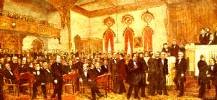 | Secession Convention E. Wood Perry c. 1861 |
The Importance of Louisiana
Because the Mississippi River formed much of Louisiana's border, control of vital ports became a strategic factor for both sides. Once war was declared, the Union's objective in Louisiana was to gain control of the Mississippi River, forcing Confederate troops to defend Louisiana and prevent Federal troops from dividing the eastern and western parts of the Confederacy along the Mississippi.
Louisiana was also strategically important as a conduit for such military supplies as munitions, foodstuffs, clothing, and livestock. Goods from Mexico and Texas flowed eastward and northward along Louisiana railroads and rivers into other Confederate states.
As a major manufacturing center, New Orleans boosted the Confederate cause during the first year of warfare, supplying armaments, clothing, knapsacks, tenting, and tinware. The Confederacy's ability to produce manufactured goods was severely curtailed by the fall of New Orleans in 1862, leaving Richmond, Atlanta, and Selma, Alabama, as the leading manufacturing centers.
In addition, workers in New Orleans shipyards constructed naval vessels for the Confederacy, including the ironclads Mississippi and Louisiana and the gunboats Livingston and Carondelet.
By November 1861 Louisiana had enrolled over 23,000 troops into Confederate service. Women also took up arms in order to protect themselves and their homes. Some women even joined Confederate units as canteen women or vivandieres.
Union Attack
Over the course of six days in April 1862, Admiral David G. Farragut, commander of the largest fleet the United States had ever assembled, bombarded the poorly defended Forts Jackson and St. Philip on either side of the Mississippi River downriver from New Orleans. Louisiana military leaders had constructed a chain- and timber- raft blockade to obstruct Union advances up the river, but damage to the chain by storms and floods weakened it, and seventeen federal vessels plowed through the blockade. The forts were captured, and both the Union and Confederacy suffered casualties in the campaign.
Port Hudson
Port Hudson was the last Confederate stronghold on the Mississippi River and the site of the longest siege in American military history. Located 250 miles downriver of Vicksburg, Port Hudson was necessary to complete the Union's control of the river. Its surrender to federal forces on July 9, 1863, after almost two months of attacks, opened up all of the Mississippi and divided the Confederacy in two.
African-American regiments from Louisiana who fought at Port Hudson on behalf of the Union were the first black units in the Civil War to engage in large-scale combat against white soldiers. The First Louisiana, made up primarily of free men of color, and the Second and Third Louisiana, composed of both free blacks and former slaves, proved their bravery by making several charges across open fields near Port Hudson. Although the charges failed, their actions laid to rest the attitude prevalent among whites that blacks would not fight. Newspaper accounts of their bravery and military capabilities helped convince northerners to accept black soldiers in the Union army.
African Americans in Gray and Blue
Statewide by early 1862 more than 3,000 free African Americans had formed military organizations, called Native Guards, and offered their services to the Confederacy. Their duties were similar to those of white home guards--protecting their areas of residence from internal and external threat. They provided their own uniforms, horses, and arms and ammunition. Some were large land- and slaveowners, who, like white planters, opposed the end of slavery and the loss of their possessions. Many free blacks recognized and wanted to maintain distinctions between themselves and slaves or the newly freed. Only a few blacks actually served alongside whites in Confederate units and received Confederate pensions.
As Union forces swept through a particular region, they attracted a large number of runaway and abandoned slaves, some of whom joined the federal army. Labeled "contraband" early in the war, former slave men and women labored for the Union as domestics, nurses, hospital orderlies, and cooks. Union officers also organized freedmen into military units, generally known as the Corps d'Afrique. Other former slave soldiers used their considerable skills to build roads, fortifications, dams, and canals, repair levees, herd cattle, shoe horses, and act as scouts and guards, in addition to fighting battles.
P. G. T. Beauregard
One of the most notable Louisianians to serve in the Civil War was P. G. T. Beauregard, a graduate of West Point and the Confederacy's first brigadier general. As commander of Confederate forces at Charleston, South Carolina, Beauregard ordered the bombardment of Fort Sumter on April 12, 1861, firing the first shot of the Civil War. Liky many Civil War troops and officers, Beauregard received his early combat experience in the Mexican War of 1846-48.
"Beast" Butler and Life in Occupied New Orleans
On April 26, 1862 Farragut and his marines raised the Union flag over the New Orleans branch of the United States Mint, today a property of the Louisiana State Museum, making New Orleans the first Confederate city captured and occupied by Union troops. Three days later he marched to city hall amidst throngs of jeering and threatening New Orleanians to take formal possession of the city. General Benjamin F. Butler and his 1,400 troops arrived in New Orleans on May 1 to take military control of the city.
Butler directed Union actions and policy during the first eight months of the occupation of New Orleans and lower Louisiana. A man of ambition and intense egotism, Butler alienated northern business interests, even though he himself was a millionaire. In both his home state of Massachusetts and in New Orleans he built his power-base on the working class, the poor, and the needy.
 | General Benjamin Butler |
Many citizens of lower Louisiana openly showed their contempt for Butler and his occupation government. They resented his orders against treating the United States flag with disrespect and showed their contempt for Union officers and soldiers by assembling in groups on public streets and singing treasonable songs. New Orleanian William Mumford was hanged by Butler for lowering the Union flag that flew over the New Orleans branch of the United States Mint. White Louisianians also objected when Butler decided to arm black troops and organize them into Native Guard units.
Although Butler managed to quiet the city's male population with the example of Mumford's hanging, New Orleans women of all social stations continued to express their disapproval and contempt for Butler. In response, Butler dispensed his inflammatory "Woman Order" on May 15, 1862. The New Orleans "Woman Order," modeled on similar ones issued in Maryland and Europe, stated:
- As the officers and soldiers of the United States have been subject to repeated insult from the women (calling themselves ladies) of New Orleans, in return for the most scrupulous non-interference and courtesy on our part, it is ordered that hereafter when any female shall, by word, gesture, or movement, insult or show contempt for any officer or soldier of the United States, she shall be regarded and held liable to be treated as a woman of the town plying her avocation [a prostitute].
This order curbed the rebellious activities of local women but made Butler a hated man. P. G. T. Beauregard was the first to call him "Beast."
Butler required all citizens who wished to remain in New Orleans and lower Louisiana to swear allegiance to the Union, ordering those who refused to do so to leave Union-held territory with only their personal clothing and no more than fifty dollars. Butler then began confiscating property belonging to enemies of the Union, earning him the name "Spoons" Butler from well-to-do New Orleanians for his rumored but unproven fondness for valuable silver spoons.
To broaden local support for the Unionist movement in southern Louisiana, Butler tried to help the poor and those left destitute by the war. He distributed beef and sugar seized by his troops to the New Orleans poor, reinstituted the free market, and organized massive projects to reconstruct the levee and clean the city's filthy streets by scouring the city and picking up trash in grimy neighborhood markets. As a result of the cleaning efforts, only two yellow fever cases were reported in 1862, although pro-southern sympathizers hoped that an epidemic would kill off General Butler and his Yankee forces.
Margaret Haughery
During the Civil War and for two decades, another citizen made efforts to lessen the hardships brought on by the war. Margaret Gaffney Haughery was a native of Ireland whose husband and daughter both died after the three arrived in Louisiana in the 1830s. Having started life as an orphan herself, she cared for children orphaned by warfare and by the epidemic diseases that constantly attacked Louisiana. To the hungry citizens of occupied New Orleans, Haughery also gave wagonloads of bread and flour, fresh from her bakery.
 | Statue of Margaret Haughery George François Mugnier c. 1890 Located on Camp Street in New Orleans, this statue was erected in 1884. |
Life of the Soldier
Over 56,000 whites from Louisiana contributed to a total Confederate force of over 850,000 soldiers and sailors. This represented more than one-sixth of the 350,000 whites residing in Louisiana when the Civil War started. In addition, about 10,000 boys, older men, and foreigners served in home-guard units, protecting and policing their homes, neighborhoods, and towns.
The clothing, equipment, and overall morale of southern soldiers deteriorated as the months and years of warfare dragged on. Most of these soldiers were in their twenties, some of them even younger, and they had to learn to cook and set up tents properly to survive the war. Military rations were fairly generous in the early stages of the war compared to those issued in the last year or two. Confederate soldiers in Louisiana continually grumbled about the numerous insect and animal pests, especially mosquitoes, that disrupted their sleeping and waking hours, but even worse than the mosquitoes were the long hours of waiting between engagements and during sieges. To fill the time, soldiers played cards, drank whiskey, sang and danced, and wrote home.
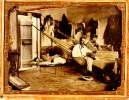 | Rebels' Den John H. Clarke c. 1861 Confederate soldiers lounging in their quarters. Gift of Mr. and Mrs. Duffy |
Union troops, like Confederate ones, also had to adjust to the life of a soldier during wartime. Their main food ration was bread and coffee, and they were just as bothered by mosquitoes and intense boredom as Confederate troops.



